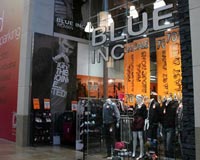 Retailers Brantano and Blue Inc called in administrators last week, potentially leaving UK landlords with as many as 216 empty shops on their hands.
Retailers Brantano and Blue Inc called in administrators last week, potentially leaving UK landlords with as many as 216 empty shops on their hands.
The demise of high street names has been a headache for property owners over the past five years, exacerbated by mergers such as that of Dixons Carphone, which this week announced it would be combining the remainder of its PC World and Currys stores, resulting in the closure of 134 shops.
Trading conditions are generally positive, with the economy and consumer spending on an upward trajectory. So why have shoe shop Brantano and clothing retailer Blue Inc faltered?
The answer? Both have failed to compete in the increasingly competitive value retail sector.
Nivindya Sharma, retail analyst at Verdict Retail, said: “Both retailers have struggled to remain relevant to an increasingly savvy consumer base. Brantano’s family shopper proposition appears dated now, with shoppers preferring to buy footwear at the grocers or at the value players such as Primark and New Look.
“Blue Inc has struggled in terms of brand and destination appeal – with its core young demographic choosing to shop at more desirable brands such as Topshop and H&M, which sell a more on-trend clothing offer.”
Both retailers are looking to reduce the size of their portfolios in an attempt to make their businesses more profitable.
Brantano made a pretax loss of £4.6m last year, despite sales growing by 6% and growth online, according to the latest figures from Companies House.
Blue Inc chief executive Steve Cohen said: “Online is becoming an increasingly big part of the business. Given the strength of online and the changing environment on the high street, we decided now was the right time to evaluate the store portfolio.”
Blue Inc, which has appointed Leonard Curtis to handle its administration, is closing 76 shops from a portfolio of 232. Of these, 53 trade as Blue Inc and 23 as Officers Club, which it bought in a £5m deal in 2011. It has an annual rent roll of £5.7m and total occupancy costs of £11.7m. Almost half the rent roll of the stores being closed comes from just 10 stores, said sources.
The retailer’s stores are typically 5,000 sq ft and are located in malls and high streets – generally high-cost locations.
Morgan Garfield, partner at shopping centre investor Ellandi, said: “These store closures seem heavily oriented towards shopping centres and retail parks, rather than town centre locations. This suggests these businesses need to better balance occupational costs with their turnover and, in this context, these higher-cost locations may not be sustainable.”
However, the closures are not all bad news for landlords, which may be able to fill the locations with aggressively expanding new entrants, such as budget fashion chain Pep & Co, which is on the hunt for around 200 shops, and value homeware store Tiger, which has a target of 100 shops in the next five years.
Brantano, which has 140 shops, called in administrators at PwC just three months after being bought by distressed-retail specialist Alteri Investors, citing trading difficulties. PwC partner Tony Barrell said the business had been “hit hard by the change in consumers’ shopping habits and the evolution of the UK retail environment”.
It operates from larger stores, averaging 10,000 sq ft, mainly in retail parks, which may suit retailers such as Dunelm, Next, or rival Shoe Zone. Earlier this month, Shoe Zone said it would close smaller shops and open 56 larger stores and trial three Project Big Box shops – properties double the size of its large, grade-1 stores. The big-box stores will be located out of town.
So while the prospect of 350 stores coming back on to the market is always a cause for concern for landlords with the poorest performing locations, there is often also opportunity to relet to fresh new names and concepts. However, with so many stores closing within the first few weeks of a new year, should landlords be bracing themselves for even more pain?
Sharma says it is tough to call. “It is difficult to say if there are more administrations to come. The value segment of the clothing and footwear retail market has felt the most pressure over the past few years as players such as New Look, H&M and Primark have become formidable competitors.”
Landlord exposure
Brantano
M&G Real Estate: 50,829 sq ft across six shops. The largest is 10,327 sq ft in Riverside retail park, Northampton.
British Land: 47,813 sq ft across seven shops. The largest is 10,056 sq ft in Wheatley shopping park, Doncaster, Yorkshire.
Standard Life Investments: 47,496 sq ft across six shops. The largest is 10,100 sq ft at Central Six in Coventry, West Midlands.
Blue Inc
Capital & Regional: 11,842 sq ft across five shops. The largest is a 5,894 sq ft shop in Marlowes shopping centre in Hemel Hempstead, Hertfordshire.
Hermes Real Estate Investment Management: Four shops, including one of 6,042 sq ft in Crompton Place, Bolton, Greater Manchester.
Intu: Four shops, including one of 2,884 sq ft at Intu Lakeside in Thurrock, Essex.
• To send feedback, e-mail amber.rolt@estatesgazette.com or tweet @AmberRoltEG or @estatesgazette










